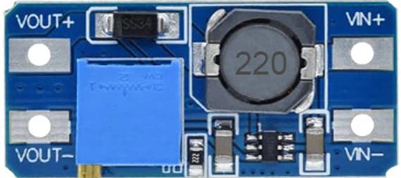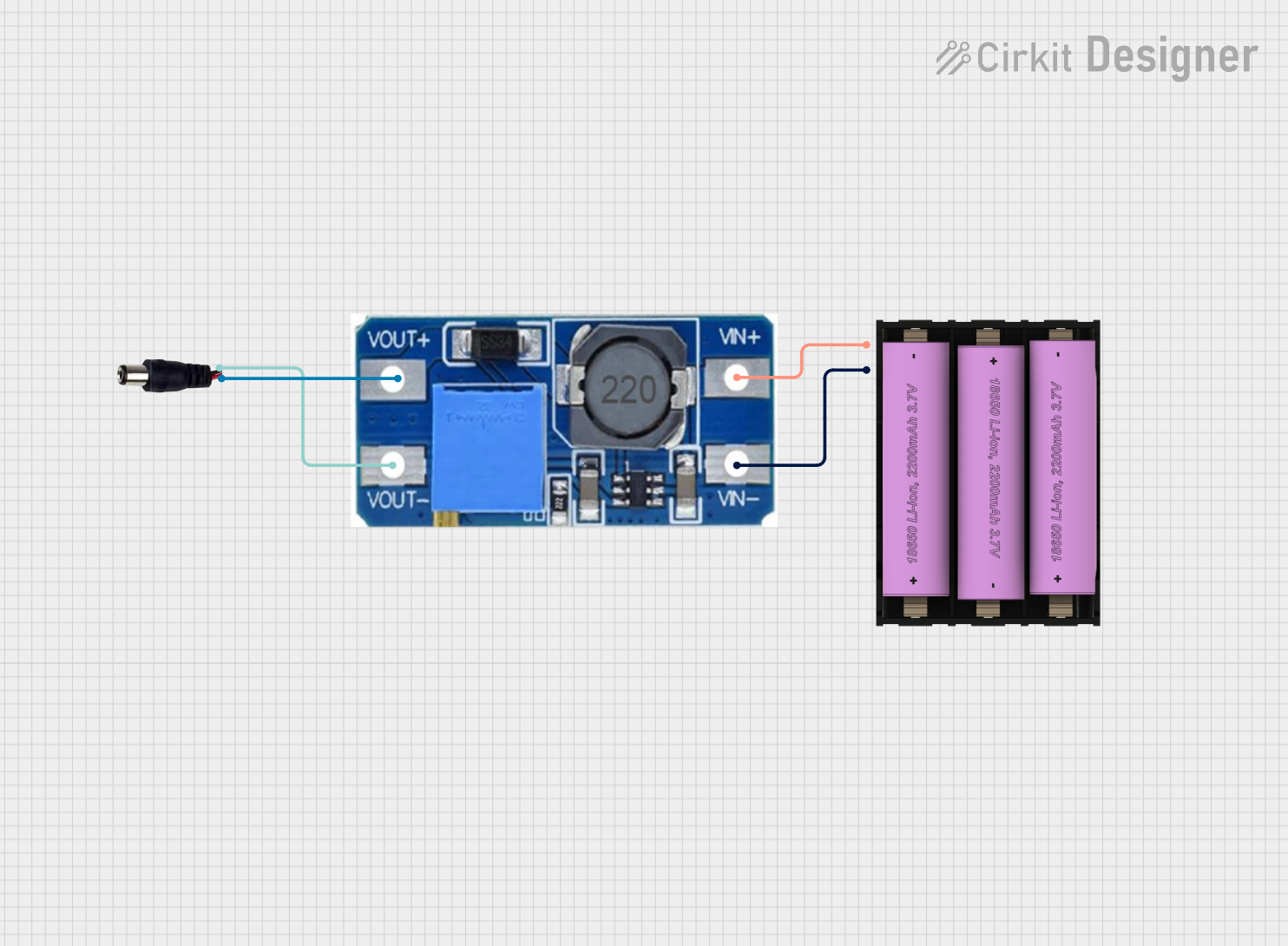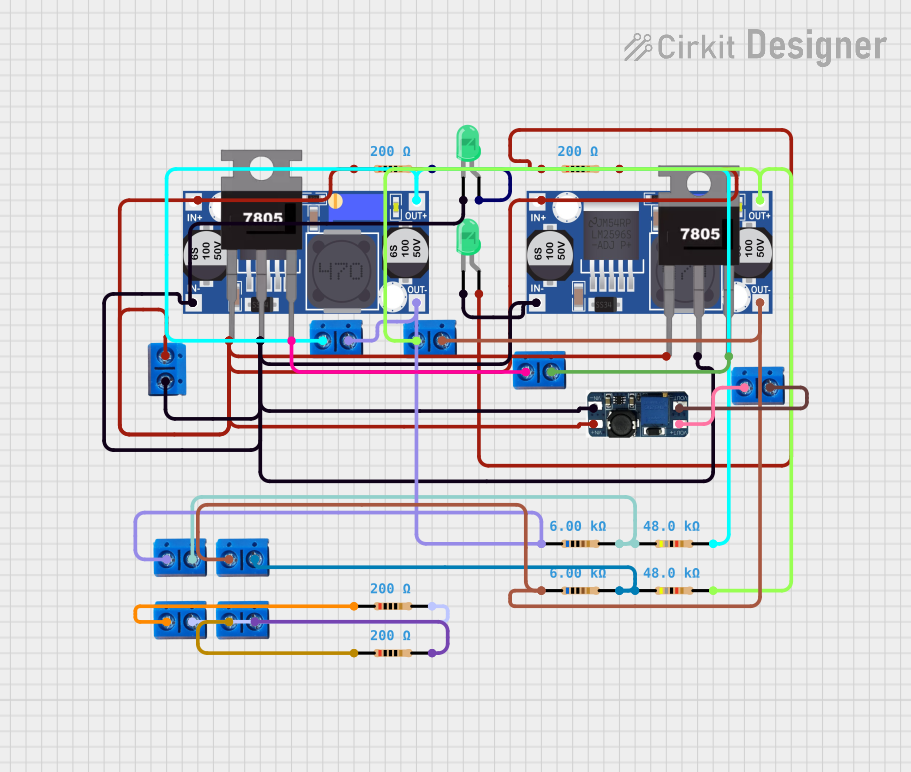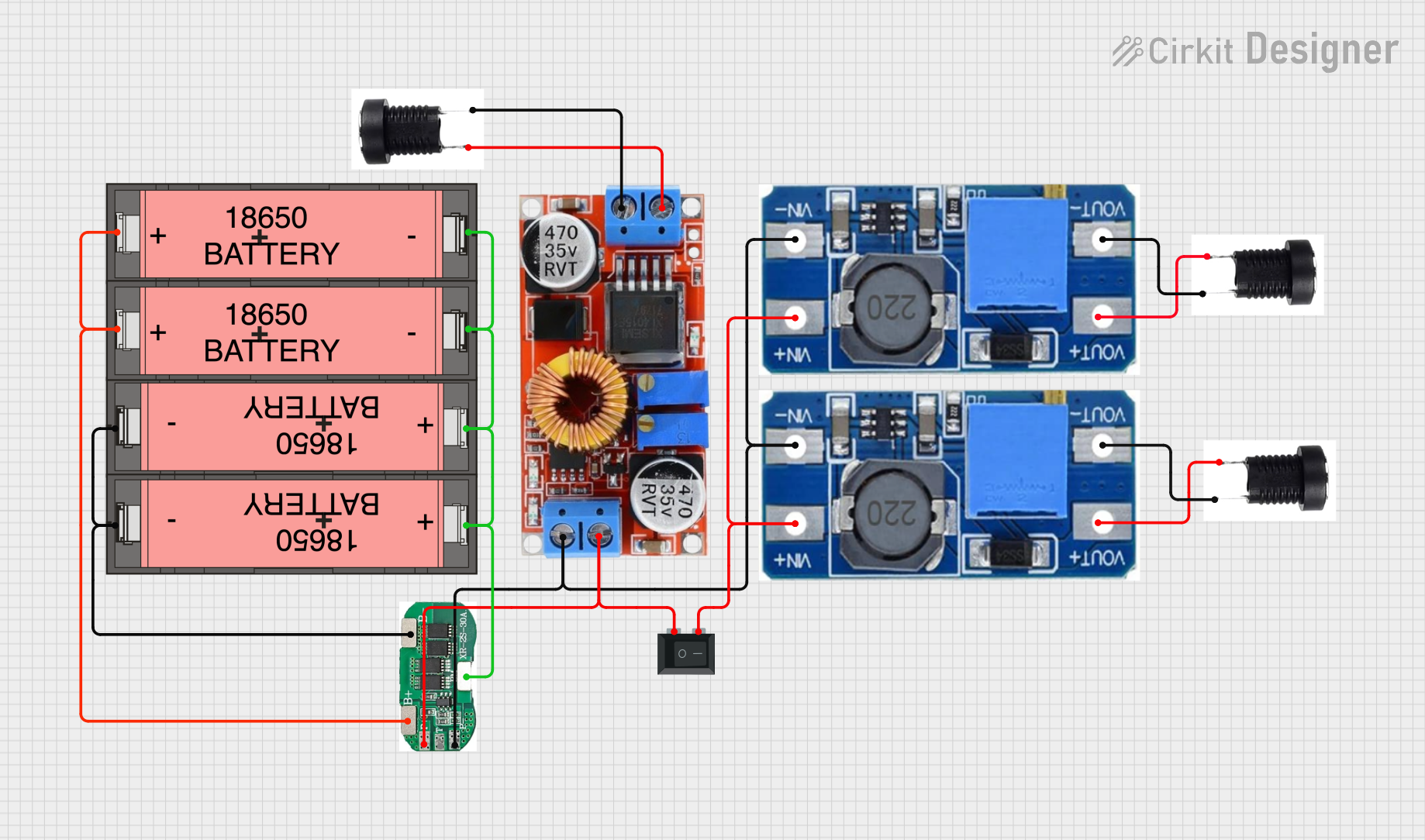
How to Use Step Up Boost Power Converter, Adjustable Voltage Regulator: Examples, Pinouts, and Specs

 Design with Step Up Boost Power Converter, Adjustable Voltage Regulator in Cirkit Designer
Design with Step Up Boost Power Converter, Adjustable Voltage Regulator in Cirkit DesignerIntroduction
The Youmile Step Up Boost Power Converter is a versatile and efficient adjustable voltage regulator designed to step up a lower input voltage to a higher, stable output voltage. This component is widely used in applications requiring a regulated power supply, such as powering microcontrollers, LED strips, battery-powered devices, and portable electronics.
Its compact design and adjustable output voltage make it ideal for hobbyists, engineers, and DIY enthusiasts working on projects that require precise voltage regulation.
Explore Projects Built with Step Up Boost Power Converter, Adjustable Voltage Regulator

 Open Project in Cirkit Designer
Open Project in Cirkit Designer
 Open Project in Cirkit Designer
Open Project in Cirkit Designer
 Open Project in Cirkit Designer
Open Project in Cirkit Designer
 Open Project in Cirkit Designer
Open Project in Cirkit DesignerExplore Projects Built with Step Up Boost Power Converter, Adjustable Voltage Regulator

 Open Project in Cirkit Designer
Open Project in Cirkit Designer
 Open Project in Cirkit Designer
Open Project in Cirkit Designer
 Open Project in Cirkit Designer
Open Project in Cirkit Designer
 Open Project in Cirkit Designer
Open Project in Cirkit DesignerTechnical Specifications
- Manufacturer: Youmile
- Model: Step Up Boost Power Converter
- Input Voltage Range: 3V to 35V DC
- Output Voltage Range: 4V to 40V DC (adjustable via potentiometer)
- Maximum Output Current: 3A (with proper heat dissipation)
- Efficiency: Up to 92% (depending on input/output voltage and load)
- Switching Frequency: 150 kHz
- Dimensions: Approximately 43mm x 21mm x 14mm
- Weight: ~10g
Pin Configuration and Descriptions
| Pin Name | Description |
|---|---|
| VIN+ | Positive input voltage terminal (connect to the positive side of the power source). |
| VIN- | Negative input voltage terminal (connect to the ground of the power source). |
| VOUT+ | Positive output voltage terminal (connect to the positive side of the load). |
| VOUT- | Negative output voltage terminal (connect to the ground of the load). |
Usage Instructions
How to Use the Component in a Circuit
Connect the Input Voltage:
- Connect the VIN+ pin to the positive terminal of your power source.
- Connect the VIN- pin to the ground terminal of your power source.
- Ensure the input voltage is within the specified range (3V to 35V DC).
Connect the Output Voltage:
- Connect the VOUT+ pin to the positive terminal of your load.
- Connect the VOUT- pin to the ground terminal of your load.
Adjust the Output Voltage:
- Use a small screwdriver to turn the onboard potentiometer.
- Turn clockwise to increase the output voltage or counterclockwise to decrease it.
- Use a multimeter to measure the output voltage while adjusting to ensure accuracy.
Power On:
- Once all connections are secure, power on the input source.
- Verify the output voltage and ensure it matches the requirements of your load.
Important Considerations and Best Practices
- Heat Dissipation: If the output current exceeds 2A, ensure proper heat dissipation by attaching a heatsink or using active cooling.
- Input Voltage: The input voltage must always be lower than the desired output voltage for proper operation.
- Polarity: Double-check the polarity of your connections to avoid damaging the module.
- Load Requirements: Ensure the load does not exceed the maximum output current of 3A.
Example: Using with an Arduino UNO
The Step Up Boost Power Converter can be used to power an Arduino UNO from a lower voltage source, such as a 3.7V Li-ion battery. Below is an example setup:
- Connect the VIN+ and VIN- pins to the battery terminals.
- Adjust the output voltage to 5V using the potentiometer.
- Connect the VOUT+ pin to the Arduino's 5V pin and the VOUT- pin to the Arduino's GND pin.
Here is a simple Arduino code example to blink an LED, powered by the boost converter:
// This code blinks an LED connected to pin 13 of the Arduino UNO.
// Ensure the boost converter is providing a stable 5V to the Arduino.
void setup() {
pinMode(13, OUTPUT); // Set pin 13 as an output pin
}
void loop() {
digitalWrite(13, HIGH); // Turn the LED on
delay(1000); // Wait for 1 second
digitalWrite(13, LOW); // Turn the LED off
delay(1000); // Wait for 1 second
}
Troubleshooting and FAQs
Common Issues and Solutions
No Output Voltage:
- Check all connections for proper polarity.
- Verify that the input voltage is within the specified range.
- Ensure the potentiometer is not turned too far counterclockwise (minimum output voltage).
Overheating:
- Reduce the load current if it exceeds 2A.
- Attach a heatsink or use active cooling to dissipate heat.
Fluctuating Output Voltage:
- Ensure the input voltage is stable and not dropping under load.
- Check for loose connections or damaged wires.
Output Voltage Not Adjustable:
- Verify that the potentiometer is functioning correctly.
- Ensure the input voltage is lower than the desired output voltage.
FAQs
Q: Can this module step down voltage?
A: No, this is a step-up (boost) converter and cannot step down voltage. Use a buck converter for step-down applications.Q: Can I use this module with a solar panel?
A: Yes, as long as the solar panel's output voltage is within the input range (3V to 35V DC).Q: Is the module protected against reverse polarity?
A: No, the module does not have reverse polarity protection. Always double-check your connections.Q: Can I use this module to charge a battery?
A: While possible, it is not recommended unless you have additional circuitry to manage the charging process safely.
By following this documentation, you can effectively integrate the Youmile Step Up Boost Power Converter into your projects and ensure reliable performance.